Greening the cities in Netherlands, part1
Urban Greening Weeks is the first challenge based international student exchange organised by EPLUG (European Platform for Urban Greening) -project. The event is hosted in two countries, Finland and Netherlands. Themes around the challenge are different in each country: in Finland the focus is on the green below the earths surface, and in Netherlands it focuses on the green above.
We are five students and our teacher in Netherlands. There are also students and teachers taking part in the challenge from Czech Repuclic and Netherlands.
Our journey started on April 10th, on second day of Easter. We took an early flight to Riga, and from there a few hours delayed flight to Amsterdam. From there by train to Utrecht. We had some slight problems with getting our room, but the issue was solved pretty fast. The room was a pleasant surprise, for it is spacey and has good bunkbeds (decent bedlinen, personal reading lights and plugs, big pillows). One weird thing though, the bathroom sink is not in the bathroom, it is next to the rooms entrance door. Also the window is pretty thin, all the chatter of a lively square below can be heard to the fifth floor, making it a little hard to get some sleep if one is a light sleeper. We had a welcome dinner at a local pizza place and got to see the faces of the people we would be working with the next two weeks. Afterwards our party was so tired we practically passed out in our beds.
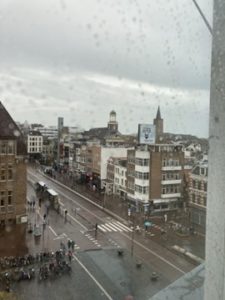
Up: the view from our hostel room
The area of Utrecht where our hostel resides is a pretty district with chunnels here and there and old European style houses crammed alongside narrow pawed roads. Immeadiately I thought it looked like tiny Copenhagen.
The second day after arrival we travelled to Houten, which is a smaller village of 50,000 people, where the headquarters of the exchange, Yuverta Park, is located. Yuverta is the largest green – blue VET (Vocational Education and Training) provider in Europe. Houten is special in a way that it is a car free village. There is a ringroad around it with entrances to sections of town from wherrom where the cars can reach the residental areas. The city central is completely car-free, with only bikers and pedestrians moving around there.
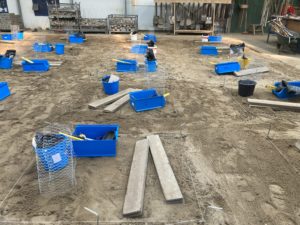
Up: In Yuverta they have a big hall for practising bases and stonelaying.

Up: They also have a big garden where they gardening and landscaping student practise gardening and pruning.
We got to know each other a little, and had a presentation about Dutch culture. We got a short lecture on biodiversity and it’s importance to everything, and then did some practical work monitoring local vegetation. It was fun to find out that the species of plants were almost all same as in Finland. It was also nice to hear the names of the plants in others native languages. We also split into three groups, with each having students from all three countries, to work together on the upcoming challenge.
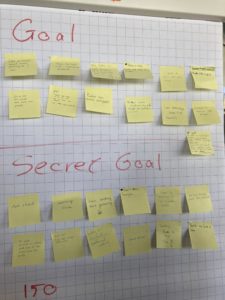
Up: We all wrote two post-it notes; the other had a goal for these two weeks, and the other a secret goal to the two weeks.
On Wednesday we got to start our challenge: the creation of a green connection between two parks in northern Houten. The area includes the Houten Centraal trainstation. A local municipality policy officer gave us a presentation of the area and the terms of the assignement. The rest of the day we spent observing the area in our challenge groups and gathering information and interviewing local people.

Up: Gerco Wicherson telling us about Houten and giving us the assignement.
We had a lecture from a local Soil Food Web lecturer on Thursday morning. After that we took a tour on Utrechts central area and saw some rooftop gardens and the Wonderwoods that was being built. We also got to know some history of Utrecths development history. In the evening we took a train to Amsterdam, because the next day we would spent touring roofgardens of the Dams.

Up: The centrum of Utrecht)
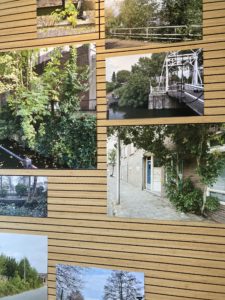
Up: We went to see a small photograph art show labout Aacidental Green.
In Amsterdam we got a long morning, and after breakfast we got an introduction to a CIRCL pavillion and it’s gardens. The representatives of Ginkel Groep joined us there for lunch and with them we moved on into the Science Museum NEMO. The Ginkel Groep built the rooftop garden there 10 years ago and they tasked us to do monitoring of the vegetation in the planters. We got a list of vegetation that was used in the rooftop, that will surely end up being helpful regarding our challenge. The rest of the day we got off, and did some touring at the local market by a canal. The writer wasn’t the only one with sore feet when we checked in the Stayokay again.
Saturday was a sunny but superwindy day that we spent in Maximapark in the borders of Utrecht and took a boat tour around the Utrecht chunnels with a guide. The park was a big place and it was designed to combine the new and the old. It had many elements and different parts, of which one was a butterfly garden designed by Piet Oudolf. In the boatride we learned much about the history of Utrecht and the parks along the chunnels.
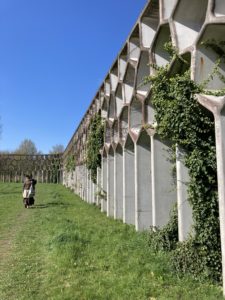
Up: Maximapark had a huge wall around it in shape of honeycombs, and the coms were filled with insect- and bat hotels and planters for climbing plants.
Sunday was a free day. Everyone slept late and did their own things. I went to see the Dom and do some souvenir shopping, did laundry and wrote my learning diary. Tomorrow starts a new week on the challenge, I’m excited to see what everyone will come up with!
Teksti ja kuvat: viheralan opiskelija Tanja

